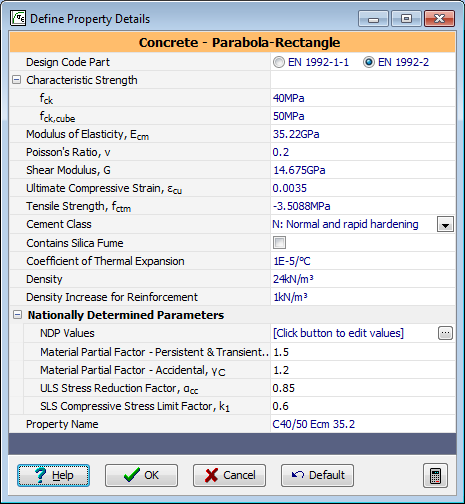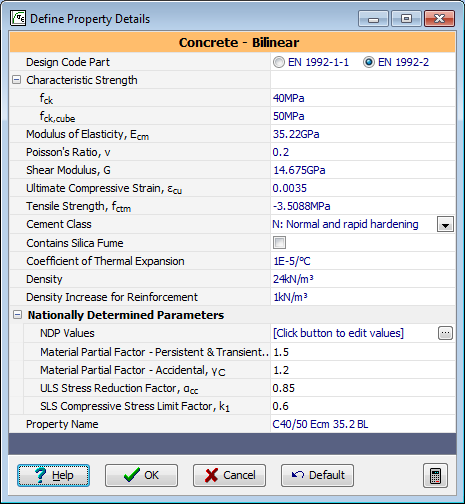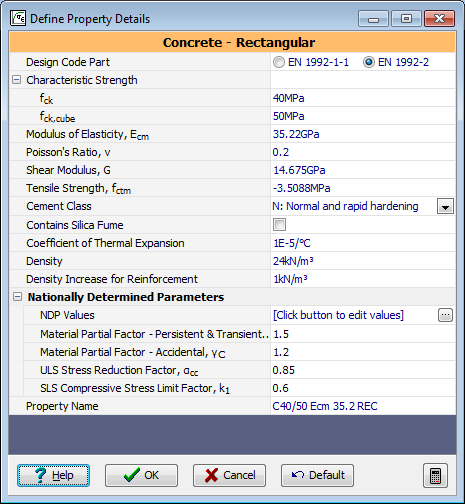Concrete Properties
Description
Definition of the material properties for a section or beam is a three step process:
- Add the material type (concrete / reinforcing steel / etc.)
- Define a set of properties for that material type (characteristic strength etc.)
- Allocate the material properties defined in 1 & 2 to the relevant parts of the section or beam section component.
This form performs the second of these 3 stages for concrete. As data is entered the program checks that values are within the expected range for concrete. This check will highlight any values in error by a factor of 10 or more. The displays for ULS and SLS are to the same scale, and are updated as the values in the fields are changed.
Relevant nationally determined parameters are displayed in this form, but these may only be edited in the Nationally Determined Parameters Form accessible through the NDP Values button.
Form Graphic



Field Help
Design Code Part
EN 1992-1-1: Clause 3.1.6-(1) identifies the value αcc as being a Nationally Determined Parameter with recommended value 1.0 (for general design).
EN 1992-2: Clause 3.1.6-(101) identifies the value αcc as being a Nationally Determined Parameter with recommended value 0.85 (for bridge design).
This radio button enables the user to select which is to be used.
Characteristic strength fck
Enter the characteristic cylinder strength of the concrete at 28 days as defined by EN 1992-1-1: Clause 3.1.2 and as used by EN 1992-1-1: Clause 3.1.6. The value will be checked to be within the range defined by the Nationally Determined Parameters and a warning issued if the value is outside the range, but the value will not be rejected. A warning will be issued if the value entered is outside the expected limits, but the value will not be rejected.
Note that use of the bi-linear and rectangular stress-strain relations should be avoided. The bi-linear relationship is appropriate only if more conservative than the parabola-rectangle (see clause 3.1.7(2)), and in addition both these alternatives are less stable for the convergence algorithms in the analysis of sections. If the rectangular stress distribution is used a 10% reduction may be appropriate in accordance with the note to clause 3.1.7 of EN 1992-1-1. This should be allowed for by reducing the characteristic strength.
Characteristic strength fck, cube
Enter the characteristic cube strength. Entering a value in this field changes the value in the Characteristic Strength, fck field (and vice versa) in accordance with the relationships defined in EN 1992-1-1: Table 3.1.
Modulus of Elasticity - Ecm
Enter the modulus of elasticity of the concrete under short term (instantaneous) loading.
The initial value is derived from the entered value of fck according to the relationship in EN 1992-1-1: Table 3.1.
As elastic modulus, shear modulus and the Poisson's ratio are related, a change of this value will affect one of the three elasticity parameters, in this case the shear modulus.
Ultimate compressive strain: εcu
The initial value is that of εcu2 (or εcu3 for the Bilinear relation) derived from the entered value of fck according to the relationship in EN 1992-1-1: Table 3.1.
εcu2 or εcu3 is appropriate for combined bending and compression. However, EN 1992-1-1: Clause 6.1-(5) requires that εcu2 or εcu3 should be used when the section is predominantly in compression. This field should be changed in that case.
Tensile strength fctm
For the serviceability limit state, a small tension stress is allowed in the concrete. The section will be analysed as uncracked provided the minimum stress does not exceed the value in this field. The default value is derived from the relationships defined in EN 1992-1-1: Table 3.1. The value is reset in whenever the characteristic strength fck is changed. However, the value may be over-ridden by entering a specific value. This field should also be used to enter a value of fctm,eff if that is required.
Note that the specified value must be negative.
Cement class
The type of cement used in the concrete has a significant effect on the rate of build up of strength of the concrete, and consequently also the creep and shrinkage properties. The strength classes are grouped as identified in EN 1992-1-1 clause 3.1.2(6). The cement type is used in the calculation of age coefficient βcc(t) in clause 3.1.2(6), which itself is used in the calculations for strength and modulus of elasticity. These affect the creep and shrinkage properties as can be seen in EN 1992-1-1 Figure 3.1, and from the expressions contained in EN 1992-1-1 Annex B.
Note also that the alternative creep and shrinkage strain evaluations in EN 1992-2 Annex B apply to concretes made with Class R cements.
Contains silica fume
The presence of silica fume in concrete has a significant effect on the shrinkage and creep parameters which is allowed for in the methods given in EN 1992-2 Annex B. This box should therefore be checked if the concrete contains an amount of silica fume of at least 5% of the cementitious content by weight. EN 1992-2 Annex B.103(103) refers.
Coefficient of thermal expansion
Enter the coefficient of thermal expansion for use in temperature calculations.
The default value is 0.00001 /°C as suggested by EN 1991-1-5: Table C1.
For lightweight concrete 0.000007 /°C should be used as indicated by EN 1991-1-5: Table C1.
Density
Enter the density of the concrete. This is used in the calculation of self-weight moments, and in the calculation of mass when beams are incorporated into a dynamic analysis.
The default value is 24 kN/m3 which is obtained from EN 1991-1-1: Table A.1. For pre-tensioned beams, in the calculation of self weight moment at transfer, Note 2 of EN 1991-1-1 Table A.1 is applied, and this value is increased by 1kN/m3.
Where the actual density is greater than this the tension stresses for pre-tensioned beams at transfer may be unduly conservative.
The value may depend upon the type of aggregate, the amount of reinforcement, and the degree of compaction.
Density Increase for Reinforcement
The increase in density of concrete resulting from reinforcement may be allowed for by specifying an incremental value here. Refer to EN 1991-1-1 Table A.1 Note 1, which gives a value of 1kN/m3 for normal percentage of reinforcing and prestressing steel.
Nationally Determined Parameters
The items under this heading cannot be edited in this form as they are Nationally Determined Parameters, and are present for information only. The values can however be edited on the NDP values form which can be accessed directly from the button on the right of this form.
Property name
The program will supply a reference name which provides an identifier to the material property set which is usually unique. This value may be edited to give a more readily recognisable name if required. For the Bilinear Relation 'BL' is appended to the name. For the Rectangular relation 'REC' is appended to the name.
